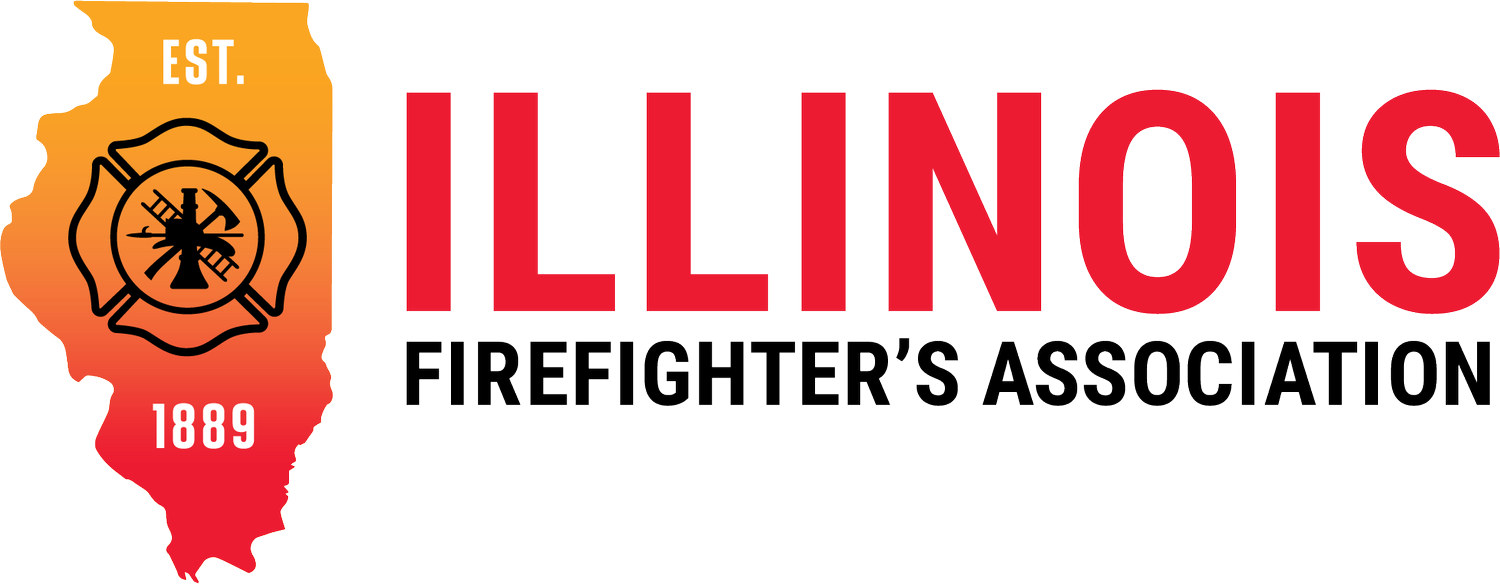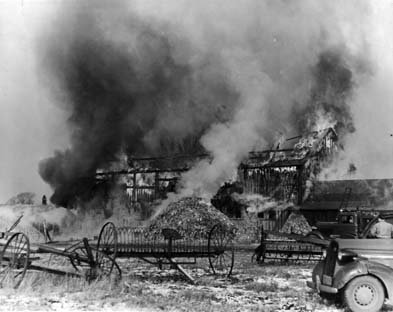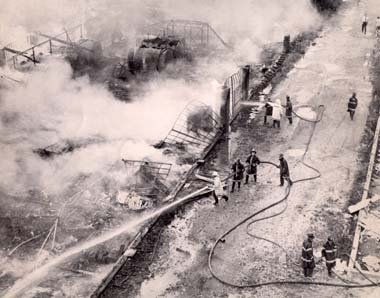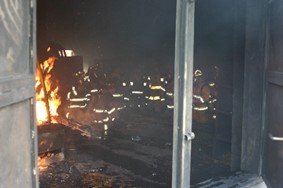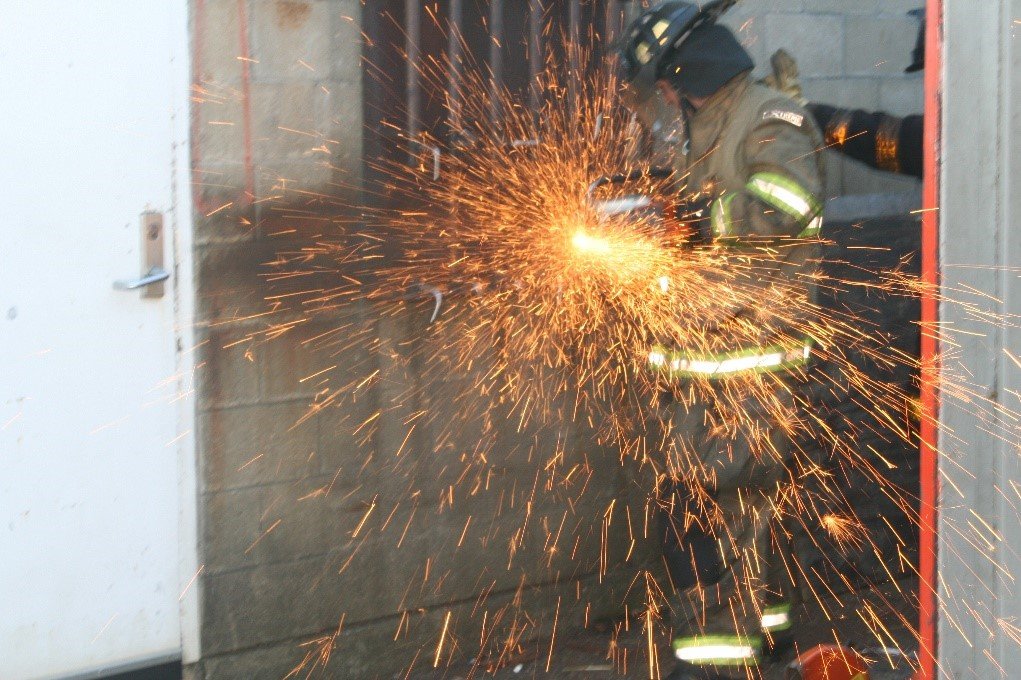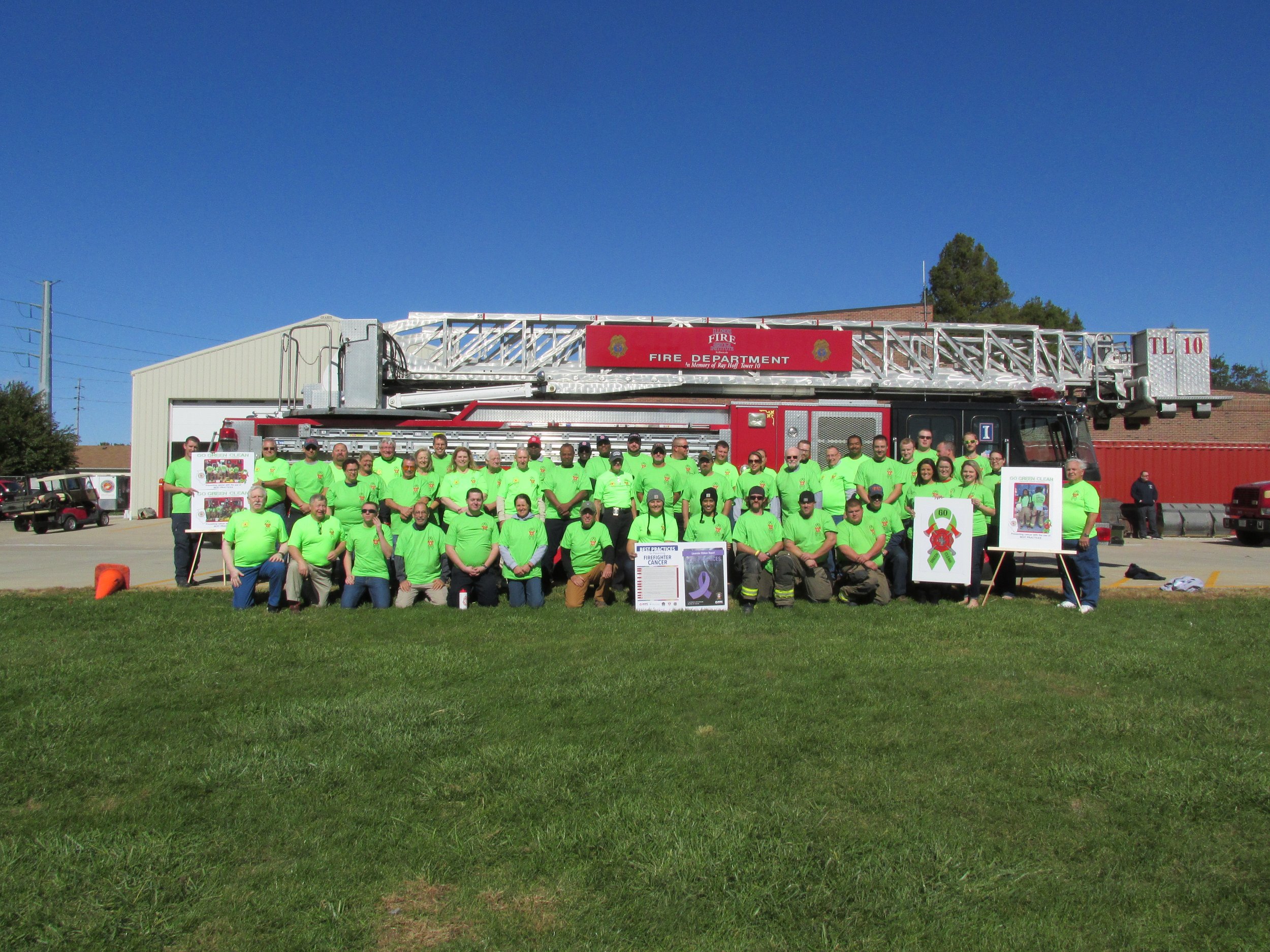IFA History
Awakening the Sleeping Giant
Firefighting was a thankless job: little or no pay, hand-me-down uniforms, long hours, antiquated equipment, dangerous working conditions, no respect, and minimal municipal support. Illinois firefighters yearned for opportunities to interact with their peers and share ideas, information and concerns.
1889-1899: Creation of an Icon
On Jan. 8, 1889, nine fire chiefs and five other delegates met in Clinton, Illinois, and formed the Illinois Firemen's Association. While gathered, they elected 12 officers, including president, secretary, treasurer and nine vice presidents, and voted to hold an annual meeting every January. At the 1891 conference, they added the office of historian. In 1899, members adopted the Accident Indemnity Fund. Many departments also elected to use the IFA's Funeral Ritual Manual to conduct last rites for fallen firefighters.
1899 Stats
IFA membership: 35 fire departments
1900-1909: IFA Fights for Life
The IFA put its members' needs first. The organization established the Past Presidents Medals award in 1905. Two years later, in 1907, the association voted to publish an annual report, Grey Book (Conference Number/Redbook). The IFA also decided to publish a bi-monthly newsletter, “The Bulletin.” Charles Chain of Bushnell and Simon Kellermann, Jr., of Edwardsville served as editors. During this era, the Illinois Office of the State Fire Marshal (OSFM) was created in 1909.
1909 Stats
IFA membership: 155 departments
1910-1919: IFA Spans State and Nation
The IFA received national recognition for its pioneering efforts. Each year, the association published three important reports: "Table of (Fire) Statistics," which was published in English and four other languages, "Table of Insurance Statistics," and "Summerical Report (of Table Data)."
In 1910, the IFA developed the first firefighter-to-firefighter recruitment program. The association helped organize the International Association of Firefighters (IAFF) in 1918 and formed the Legislation Committee to monitor state and federal legislation.
1910 Stats
IFA membership: 162 departments
1920-1929: Getting Things Under Control
The IFA helped five departments meet manpower shortages and was depended on for more proper fire protection and better capabilities. In 1922, three members were elected to offices at the National Fire Association Conference in Ludington, Michigan. In 1924, the IFA began sending two or more delegates to this yearly meeting.
In 1925, the association helped establish the Illinois Fire College (IFC, now known as the IFSI). The IFC was reportedly the first fire college in the U.S. and had an enrollment of 210 students.
At the 1927 conference, the meeting date was changed. Thus, a second conference convened in September. The same year, the IFA donated $10,000 to build a training tower and smoke house at IFC. In 1928, the Grey Book appeared as the IFA Conference Number (Redbook).
1923 Stats
IFA membership:
290 departments
49 past officers
18 associates
1930-1939: Picking Up Pieces after the 1929 Crash
In the 1930s, America fell into a major depression. Fire departments lost revenue. More departments transferred apparatus from one department to another. IFA membership, convention attendance, and participation dropped. Yet, morale remained very high. In 1931, the organization implemented its Firefighters and Manufacturer's Communication Program to advance apparatus design and engineering for fire protection in cities, towns and rural areas.
1933 Stats
IFC enrollment: 341
1940-1949: Challenges on the Home Front
Fire departments scraped for materials, money and manpower during World War II. Due to these financial constraints, the IFA held no conference from 1943 to 1945.
In 1946, the association helped health care facilities implement fire prevention programs. It also helped firefighters conduct industrial inspections, particularly in war production plants.
During this period, the IFA pushed for three pieces of legislation:
To limit the work week to 60 hours;
To pay pension at the time of disability or retirement; and
To eliminate the 10-year active service requirement for pension eligibility.
At the 1949 conference, dues increased to $10. Expert instructors conducted a record number of 16 education talks.
1946 Stats
IFC (IFSI) enrollment: 353
IFC (IFSI) courses: 43
IFA membership: 476 departments/fire protection districts
1950-1959: Evolutions of Change
By 1952, the IFA served as the largest fire service organization in the U.S. Membership exceeded 610 departments and associates with display privileges. The annual conference drew record crowds, and exhibit space revenue soared to over $1,070 in 1954.
Members helped create Illinois' Mutual Aid System, one of the first in the country. The association helped implement civil defense and water conservation programs, helped establish the first burn treatment centers and aided volunteer departments in acquiring surplus government apparatus.
1946 Stats
IFSI enrollment in 1951: 606
IFSI fire instructors trained in 1958: 26
IFA membership in 1952: 375 fire protection districts
IFA membership in 1959: 700 departments, 40,000 individuals
1960-1969: Planning for Progress
In the 1960s, the IFA was the third oldest firefighter service organization in America. In 1962, delegates voted to increase departmental dues to $20. Three years later, the association set the treasurer's bond at $20,000. The IFA also raised the per-man assessment five cents to increase the Indemnity Fund death benefit to $2,000. The association also passed a resolution to legislate for the Illinois Fire Marshal’s job to become a permanent post. The Ladies Auxiliary of the Illinois Fireman’s Association (LAIFS) became a regular donor to IFA projects.
1946 Stats
IFSI enrollment: 11,476
IFSI training centers: 187
IFA membership: 725 fire protection districts
1970-1979: Putting the Public at Rest
The Vietnam War impacted the ability of fire departments to sustain operations and promote growth. More departments actively recruited women.
In 1970, the IFA co-founded the Joint Council of National Fire Services Organizations (JCNFSO). The council worked in 1972 with 166 fire departments to develop a list of 23 subjects for curriculum under the Illinois Fire Protection Personnel and Education Commission.
The IFA also pushed for passage of legislation that established the National Fire Academy (NFA) in 1975 under the National Fire Protection Association (NFPA). Then, it helped the University of Illinois win designation as an NFA site. The association also supported the National Volunteer Fire Council (NVFC).
1970s Stats
IFA membership: 565 departments/fire protection districts
1980-1989: Reaching for New Heights
In 1980, the IFA adopted Illinois Firefighter's Association (IFA) as its new name. A key player in the industry, it influenced apparatus/gear design, fire prevention programs, legislation, fire suppression strategies, safety standards, curriculum, certifications, and even recruitment criteria.
The association focused on improving communication, conference programs, membership services, education classes, and fundraising efforts. In 1982, members raised $108,000 for the Muscular Dystrophy Foundation.
Conferences were held in the same community two consecutive years. Workshops emphasized management and technology. Major companies paid to print new training packets. In addition, "Lunch with Distributors" became a regular, favorite conference event.
At the 1986 conference, delegates honored 121 fallen firefighters during a memorial service. In 1989, the IFA held its 100th annual conference in Collinsville. The Madison County Firemen's Association (MCFA) became an annual donor.
1989 Stats
IFA membership: 700 departments, 44,000 individuals
1990-1999: The Sleeping Giant Roars
The IFA celebrated as the association’s clout spread. Members impacted consumer product safety, fiber content, building materials' design and composition, building design and construction, vehicle design and engineering, health care administration, emergency services, and more.
The association helped firefighters gain representation in state government and the U.S. Congressional Fire Caucus (USCFC). The IFA also helped develop professional leadership/administrative training curriculum. The association led fundraising efforts for the Illinois Fallen Firefighters Memorial, co-sponsored the LAIFA Bi-Annual Illinois Children's Burn Camp Auction and supported the Illinois Fire Chief's Association Scholarship Fund (IFCASF).
In 1999, the IFA celebrated its 110th year. It operated with 13 committees: Advisory, Education/Training, Exhibits/Promotions, Legislative/Judiciary, Membership, Memorial, Conference/Programs, Resolutions, NVFC, Historian, Credentials/Election, Registration, and IFA Foundation.
1998 Stats
IFSI in 1998 served: 1,200 departments/fire protection districts, 23,000 firefighters
IFSI programs offered in 1998: 400
IFA membership in 1999: 550+ departments/fire protection districts, 44,000 individuals, 24 past presidents, 26 associates, 40 associates/display
2000 and Beyond
The IFA and its members respect change. Departments, fire protection districts, and individual members alike pursue and appreciate the opportunity to serve as:
Technical consultants/experts to research and development companies, scientists, chemists, architects, engineers, designers, planners, etc.;
Industry consultants to business, industry, manufacturing, technology, education, government, labor, media publishing, etc; and
Members of think tanks, task forces, commissions, advisory boards, councils, and committees in both the public and private sectors.
Internally, the association is spearheading programs related to these areas: membership and employment, legislation and policy, public relations and communications, corporate and economic development, industrial and business relations, co-op corporate sponsorships, technological interfacing, networking and information management, professional and administrative services, leadership training and development, conference meeting and planning, and membership, employee, customer and constituent services.
In 2000, the IFA partnered with the Illinois Office of the State Fire Marshal (OSFM) and the Illinois Fire Service Institute (IFSI) to introduce the Illinois Fire College, which offered reimbursable classes to Illinois firefighters. Classes were also offered on a region-wide basis. This, along with other initiatives, was the “Vision 2000” plan outlined by the IFSI. The OSFM also introduced task forces such as the Governor’s Blue Ribbon Panel, Claims Reimbursement Task Force and Terrorism Task Force. The IFA’s website (www.illinoisfirefighters.org) was also launched to strengthen communication between the IFA and its membership, disseminate information and provide links to other fire services associations. On the federal level, the National Fire Caucus presented two bills to Congress, including the Fire Bill and the Volunteer Fire Service Bill.
In 2001, the IFA participated in a combination conference with the Illinois Fire Chief’s Association and the IFSI. The OSFM stressed the importance of the Illinois Fire Service working together and the necessity for continued growth after the events of Sept. 11, 2001. The IFSI introduced the “Cornerstone Program,” a reimbursable program that offers various fire service trainings to Illinois firefighters. The IFA and IFSI also partnered on the “Down & Dirty” training program and delivered training CD sets to member departments. The deliveries enabled the IFSI training to be shared at the member department level, making the important training available to firefighters who were unable to attend IFA’s annual conference.
In 2002, the Illinois Fire Chief’s Association and the IFSI held another combined conference. IFSI explained the development of the “Down & Dirty” CDs and combined efforts with the IFA executive board. The Cornerstone and Homeland Security programs are still in existence, but funding is at a lull. Hazmat awareness is available online and at no cost.
In 2003, the IFA accomplished several initiatives such as letters being sent to the President and federal legislators to keep the Fire Act Grant Funded, and the President sent a response. The IFA formed a partnership with IFSI to provide insurance benefits to the membership, and lobbyist Margaret Vaughn was brought in to be a voice for the IFA on the state level.
In 2004, the IFA decided to form a special partnership with the IFSI, Illinois’ state fire academy to begin the “Down & Dirty” Firefighter Weekend. The weekend consisted of a combination of classroom and hands-on training. During the event, IFA member departments were able to receive training from the IFSI instructors and full use of the academy facility for training.
The partnership between IFA and IFSI grew closer in 2005 with the second “Down & Dirty” Firefighter Conference, in addition to the CD-based training program. The board attended various conferences, including the National Benefit Summit. The Job Security Act came out of this summit.
The 2006 conference continued the partnership with IFSI with over 50,000 people in the state being trained through IFSI since the last conference. The state of Florida asked permission to distribute the “Down & Dirty” CD/DVD program to firefighters in its state. In return, the University of Florida offered an online bachelor’s degree program in fire science at the Florida in-state tuition rate. The IFSI library was expanded in the international network of fire service libraries so its trainings can be obtained all over the world. On the legislative side, bills passed to date have been the Fire Sprinkler Dormitory Revolving Loan Fund Act, Arsonist Registration Act, Volunteer Firefighter Job Protection Act, Fire Prevention Funds Protected, Rotating Lights and Impersonating a Firefighter.
In 2007, the OSFM offered free NFIRS classes. Departments with firefighters who took the classes would get a laptop computer and printer to allow for electronic filing of reports. Additionally, IFSI discussed a plan to have firefighter awareness training surrounding ethanol plants. There were 100 million bushels of ethanol moving in and out of processing plants.
IFSI, in 2008, worked with the aerial apparatus manufacturer's factories to develop an additional training disc for the “Down & Dirty” DVD training program. The apparatus manufacturers asked if copies of the DVDs could be supplied every time they sold new aerial apparatus as they found this to be a great training aid. A new DVD on Fire Attack is the next project for the “Down & Dirty” DVD program. Videos were provided on the IFSI website for ethanol and foam training. IFSI expanded international training relations with China.
In 2009, the OSFM developed a portal for the state NFIRS reports, enabling departments to check their reports on the internet instead of via emails. The change allows anytime access for departments to check the reporting status of their NFIRS reports.
Self-extinguishing cigarette legislation was passed, addressing the leading cause of residential fire deaths.
Legislation was passed requiring all fraternities and sororities to test sprinklers in their buildings within a nine-year time frame.
State fire code requires all new residential construction to have residential sprinklers in one- and two-family dwellings as well as hard-wired smoke detectors.
The Cornerstone Program became an official line item in the state fire marshal’s budget. “Fires On The Farm” was added to the Cornerstone Program.
IFSI added “Crude Oil by Rail Awareness” and “Ops Courses.”
OSFM is looking into electronic testing for certification.
“New Grain Bin Rescue” training is being rolled out.
Recruitment and retention, fundraising and revenue, data management, benefits and financial security are still the biggest and most common issues in the fire service today.
Legislation passed on volunteer firefighter tire purchase on state bid pricing.
The IFA continues to serve and advance.
2018: GO GREEN CLEAN
Exposure to toxic environments and chemicals is a real concern for the firefighting community, but proper training and awareness can help mitigate risks and help prevent cancer and other health concerns.
In 2018, IFA implemented the GO GREEN CLEAN program to bring awareness about the increasing number of firefighter cancer illnesses and issues and the best practices for prevention. The program is offered free of charge to all members as part of the IFA’s commitment to their health and well-being.
Firefighters face a 9% higher risk of being diagnosed with cancer and a 14% higher risk of dying from cancer than the general U.S. population. Exposure to toxic environments and chemicals while fighting fires is the major culprit.
GO GREEN CLEAN is based on current research outlined in the Lavender Ribbon Report. The program teaches firefighters best practices to follow in reducing the risks of cancer caused by chemical exposure, including proper protocols to decontaminate skin and protective gear in timely and efficient ways. The program also provides fire departments with the necessary decontamination equipment.
The IFA collaborated with the Illinois Office of the State Fire Marshal to create the program for its members.
2021-2022: New Logo / Rebranding
In the 2021-2022 fiscal year, the IFA launched a new logo and updated its overall branding strategies. The association’s website, publications and social media channels were updated to reflect the new look.
The rebranding project was completed in partnership with Creative Entourage in 2021 in order to better market the IFA and gain participation by more Illinois fire departments. The organization also hoped to appeal to a younger generation by using a more streamlined design.
The IFA solicited ideas from its membership before choosing a final design. Along with standardizing fonts, colors and logo use for the website, the Creative Entourage team created digital messaging, IFA brochures, materials for a new event booth display and other published materials.
The new logo marks only the third iteration since the IFA was formed in 1889, and the design honors that long history by prominently featuring the founding year.
OUR MISSION
Dedicated to the advancement of the Fire Service by providing leadership. The Illinois Firefighter’s Association will proudly support the health and welfare of the community of firefighters in Illinois through education, training, benefits and information networking at the local, state and national levels.
